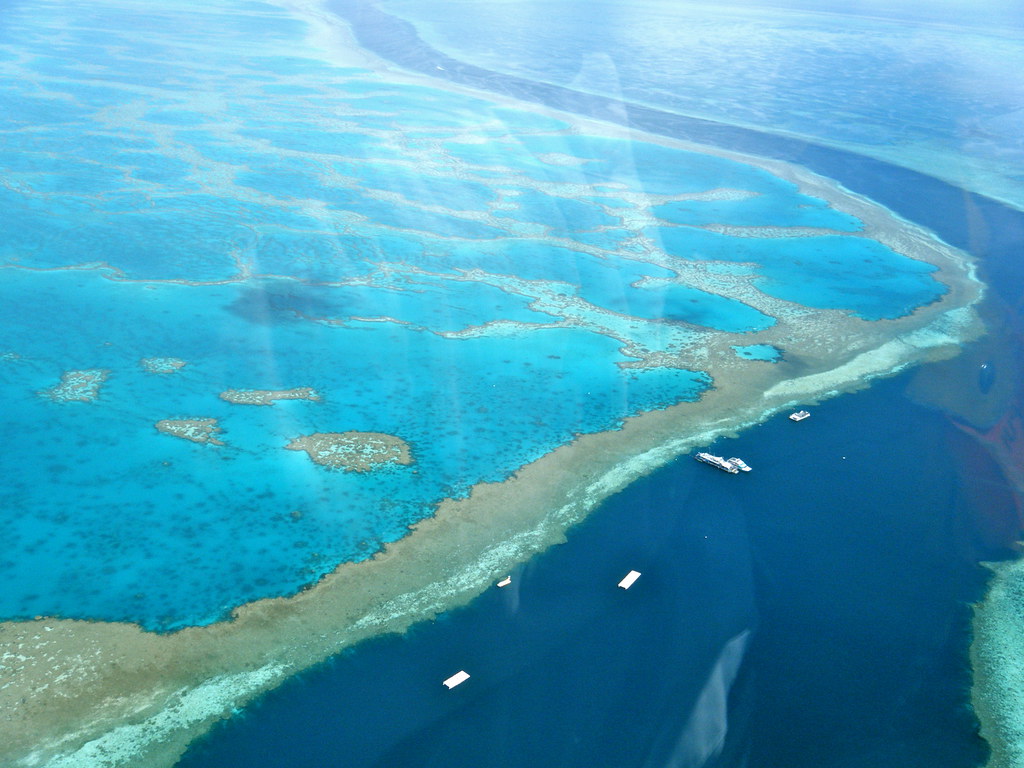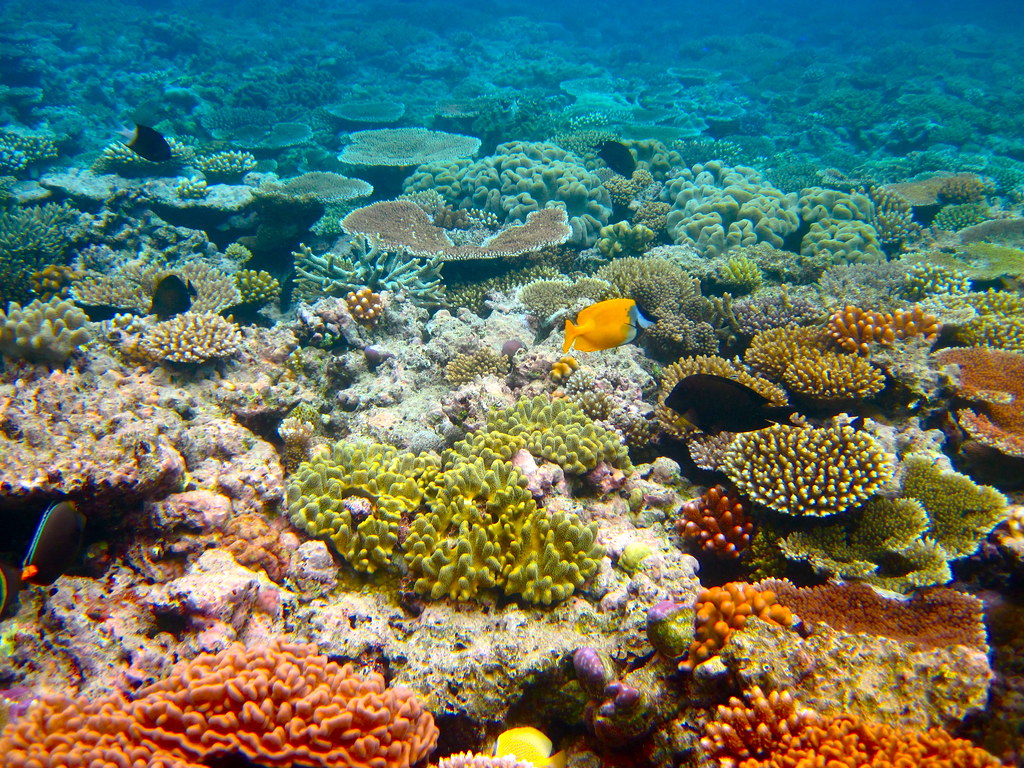
 Australia
Australia
Off the east coast of the Queensland mainland
S18 17 10 E147 41 60
Date of Inscription: 1981
Criteria: (vii)(viii)(ix)(x)
Property : 34,870,000 ha
Ref: 154
News Link/Travelogue: AUSTRALIA; AU – GREAT BARRIER REEF

As the world’s most extensive coral reef ecosystem, the Great Barrier Reef is a globally outstanding and significant entity. Practically the entire ecosystem was inscribed as World Heritage in 1981, covering an area of 348,000 square kilometres and extending across a contiguous latitudinal range of 14o (10oS to 24oS). The Great Barrier Reef (hereafter referred to as GBR) includes extensive cross-shelf diversity, stretching from the low water mark along the mainland coast up to 250 kilometres offshore. This wide depth range includes vast shallow inshore areas, mid-shelf and outer reefs, and beyond the continental shelf to oceanic waters over 2,000 metres deep.
Within the GBR there are some 2,500 individual reefs of varying sizes and shapes, and over 900 islands, ranging from small sandy cays and larger vegetated cays, to large rugged continental islands rising, in one instance, over 1,100 metres above sea level. Collectively these landscapes and seascapes provide some of the most spectacular maritime scenery in the world.
The latitudinal and cross-shelf diversity, combined with diversity through the depths of the water column, encompasses a globally unique array of ecological communities, habitats and species. This diversity of species and habitats, and their interconnectivity, make the GBR one of the richest and most complex natural ecosystems on earth. There are over 1,500 species of fish, about 400 species of coral, 4,000 species of mollusk, and some 240 species of birds, plus a great diversity of sponges, anemones, marine worms, crustaceans, and other species. No other World Heritage property contains such biodiversity. This diversity, especially the endemic species, means the GBR is of enormous scientific and intrinsic importance, and it also contains a significant number of threatened species. Attime of inscription, the IUCN evaluation stated “… if only one coral reef site in the world were to be chosen for the World Heritage List, the Great Barrier Reef is the site to be chosen”.
Criterion (vii): The GBR is of superlative natural beauty above and below the water, and provides some of the most spectacular scenery on earth. It is one of a few living structures visible from space, appearing as a complex string of reefal structures along Australia’s northeast coast.
From the air, the vast mosaic patterns of reefs, islands and coral cays produce an unparalleled aerial panorama of seascapes comprising diverse shapes and sizes. The Whitsunday Islands provide a magnificent vista of green vegetated islands and spectacular sandy beaches spread over azure waters. This contrasts with the vast mangrove forests in Hinchinbrook Channel, and the rugged vegetated mountains and lush rainforest gullies that are periodically cloud-covered on Hinchinbrook Island.
On many of the cays there are spectacular and globally important breeding colonies of seabirds and marine turtles, and Raine Island is the world’s largest green turtle breeding area. On some continental islands, large aggregations of over-wintering butterflies periodically occur.
Beneath the ocean surface, there is an abundance and diversity of shapes, sizes and colours; for example, spectacular coral assemblages of hard and soft corals, and thousands of species of reef fish provide a myriad of brilliant colours, shapes and sizes. The internationally renowned Cod Hole near Lizard Island is one of many significant tourist attractions. Other superlative natural phenomena include the annual coral spawning, migrating whales, nesting turtles, and significant spawning aggregations of many fish species.
Criterion (viii): The GBR, extending 2,000 kilometres along Queensland’s coast, is a globally outstanding example of an ecosystem that has evolved over millennia. The area has been exposed and flooded by at least four glacial and interglacial cycles, and over the past 15,000 years reefs have grown on the continental shelf.
During glacial periods, sea levels dropped, exposing the reefs as flat-topped hills of eroded limestone. Large rivers meandered between these hills and the coastline extended further east. During interglacial periods, rising sea levels caused the formation of continental islands, coral cays and new phases of coral growth. This environmental history can be seen in cores of old massive corals.
Today the GBR forms the world’s largest coral reef ecosystem, ranging from inshore fringing reefs to mid-shelf reefs, and exposed outer reefs, including examples of all stages of reef development. The processes of geological and geomorphological evolution are well represented, linking continental islands, coral cays and reefs. The varied seascapes and landscapes that occur today have been moulded by changing climates and sea levels, and the erosive power of wind and water, over long time periods.
One-third of the GBR lies beyond the seaward edge of the shallower reefs; this area comprises continental slope and deep oceanic waters and abyssal plains.
Criterion (ix): The globally significant diversity of reef and island morphologies reflects ongoing geomorphic, oceanographic and environmental processes. The complex cross-shelf, longshore and vertical connectivity is influenced by dynamic oceanic currents and ongoing ecological processes such as upwellings, larval dispersal and migration.
Ongoing erosion and accretion of coral reefs, sand banks and coral cays combine with similar processes along the coast and around continental islands. Extensive beds of Halimeda algae represent active calcification and accretion over thousands of years.
Biologically the unique diversity of the GBR reflects the maturity of an ecosystem that has evolved over millennia; evidence exists for the evolution of hard corals and other fauna. Globally significant marine faunal groups include over 4,000 species of molluscs, over 1,500 species of fish, plus a great diversity of sponges, anemones, marine worms, crustaceans, and many others. The establishment of vegetation on the cays and continental islands exemplifies the important role of birds, such as the Pied Imperial Pigeon, in processes such as seed dispersal and plant colonisation.
Human interaction with the natural environment is illustrated by strong ongoing links between Aboriginal and Torres Strait Islanders and their sea-country, and includes numerous shell deposits (middens) and fish traps, plus the application of story places and marine totems.
Criterion (x): The enormous size and diversity of the GBR means it is one of the richest and most complex natural ecosystems on earth, and one of the most significant for biodiversity conservation. The amazing diversity supports tens of thousands of marine and terrestrial species, many of which are of global conservation significance.
As the world’s most complex expanse of coral reefs, the reefs contain some 400 species of corals in 60 genera. There are also large ecologically important inter-reefal areas. The shallower marine areas support half the world’s diversity of mangroves and many seagrass species. The waters also provide major feeding grounds for one of the world’s largest populations of the threatened dugong. At least 30 species of whales and dolphins occur here, and it is a significant area for humpback whale calving.
Six of the world’s seven species of marine turtle occur in the GBR. As well as the world’s largest green turtle breeding site at Raine Island, the GBR also includes many regionally important marine turtle rookeries.
Some 242 species of birds have been recorded in the GBR. Twenty-two seabird species breed on cays and some continental islands, and some of these breeding sites are globally significant; other seabird species also utilize the area. The continental islands support thousands of plant species, while the coral cays also have their own distinct flora and fauna.
Suggested Base:
Townsville is a laid-back coastal city of around 200,000 people in Far North Queensland, Australia. Townsville is on the coast and enjoys an average of 320 days of sunshine a year. It is an appealing place for locals and a great jumping off point for visitors, especially to Magnetic Island which is only 25-45 minutes by passenger or car ferry. A great spot for visitors wanting a taste of outback Australia while not venturing far from the coast. It offers a quiet cosmopolitan feel with its good choice of restaurants & bars but also has a relaxing siesta style during the hottest parts of the day in high summer. Townsville takes great pride in being the unofficial Capital of North Queensland. The Sunbus bus route operates 7 days a week with 7 main lines going around the town. [read more]
Cairns is touted as the “gateway to the Great Barrier Reef” and other destinations such as Kuranda and the Daintree rainforest in Far North Queensland, Australia, although the city itself has little to offer to travelers besides tour agencies, a handful of restaurants, cafes, and backpacker bars, and a long walk along the espalade looking out at the swampy shoreline. Its 150,000 residents are regularly outnumbered by domestic and international visitors. The Cairns area was historically inhabited by the indigenous Walubarra Yidinji people. Mapped by James Cook and named Trinity Bay in 1770, it was officially founded in 1876 as an export port for gold and renamed after the then-Governor of Queensland. Commonly mispronounced as cans, the actual pronunciation of Cairns is somewhat closer to kare-nz, with a non-silent “r”. The main industry is tourism, with focus on the European, Japanese and increasingly Chinese markets. [read more]
Mackay is a tropical city on the eastern coast of the Australian state of Queensland, some 900 km north of the state capital Brisbane. Limited bus services run in the Mackay region. Cars can be hired from the airport. Taxis are available from major shopping centres and individuals can call the service to be picked up from a specified destination. Bicycles (push bikes) are a good fit for city transportation. Projects are ongoing to expand current bicycle routes, one long route exists from West of the city to the Canelands shopping area. The main industries of Mackay are coal mining and Sugar Cane, Mackay being the “Sugar Capital of Australia”. Many use Mackay as a stopping point for lucrative mining work in the Bowen Basin of central Queensland. Mackay has two major shopping centres, Mount Pleasant Greenfields located on the Corner Phillip Street and the Bruce Highway. [read more]

Leave a comment